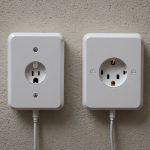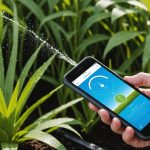Unlock Smart Irrigation: Your Ultimate Smartphone Handbook for Optimal Sprinkler Control and Maximum Water Savings
In the era of smart home devices and advanced technology, managing your irrigation system has never been more efficient or water-friendly. Smart irrigation systems are revolutionizing the way we care for our lawns, gardens, and crops, and this guide will walk you through everything you need to know to get started.
Understanding Smart Irrigation Systems
Smart irrigation systems are designed to optimize water use based on real-time environmental data, making them a game-changer for both home gardeners and farmers. Here’s how they work:
This might interest you : Unleash the Full Potential of Your Smartphone for Epic Augmented Reality Gaming: Essential Tips for Optimal Performance
Key Components of Smart Irrigation Systems
Smart irrigation systems typically include several key components that work together to ensure your plants receive the right amount of water at the right time.
- Soil Moisture Sensors: These sensors measure the moisture content of the soil to determine the exact water needs of your plants. This prevents overwatering and ensures that your plants are always hydrated but not waterlogged[5].
- Weather Forecasting Integration: Smart irrigation systems can connect to local weather data, adjusting watering schedules based on upcoming rain, temperature, and humidity. For example, the B-hyve Smart Indoor/Outdoor Irrigation Controller uses WeatherSense® technology to automatically delay watering if rain is forecasted[3].
- Remote Control Capabilities: With smartphone apps, you can monitor and adjust your irrigation schedules remotely. This flexibility is particularly useful for large farms or for those who are often away from home[5].
Choosing the Right Smart Irrigation Controller
When selecting a smart irrigation controller, there are several factors to consider to ensure you get the best fit for your needs.
Features to Look For
Here are some key features to look for in a smart irrigation controller:
- Multi-Zone Control: Controllers like the Lumary Smart Sprinkler Timer and the B-hyve Smart Indoor/Outdoor Irrigation Controller allow you to customize watering schedules for different zones within your property. This is especially useful if you have areas with different plant types or soil conditions[1][3].
- Rain Delay and Weather Adjustments: Look for controllers with built-in rain delay functions and weather integration. These features ensure that your sprinklers do not come on during rainy days and adjust the watering schedule accordingly[1][3].
- Smart Connectivity: Ensure the controller can connect to your WiFi network and is compatible with your smartphone. The Lumary Smart Sprinkler Timer, for instance, connects to a 2.4GHz WiFi network and can be controlled via the Lumary app[1].
- Voice Control: For added convenience, consider controllers compatible with voice assistants like Amazon Alexa or Google Assistant. The B-hyve controller, for example, can be controlled using voice commands through Amazon Alexa or Google Home[3].
Comparison of Popular Smart Irrigation Controllers
Here’s a comparison of some popular smart irrigation controllers to help you make an informed decision:
| Feature | Lumary Smart Sprinkler Timer | B-hyve Smart Indoor/Outdoor Irrigation Controller |
|---|---|---|
| App Compatibility | iOS, Android | iOS, Android |
| Smart Home Compatibility | Amazon Alexa, Google Assistant | Amazon Alexa, Google Assistant |
| Rain Delay | Yes, 24, 48, or 72 hours | Yes, automatic based on weather forecast |
| Multi-Zone Control | Yes, up to 2 zones | Yes, up to 12 zones |
| Soil Moisture Sensors | Not included but compatible | Compatible with most rain/freeze sensors |
| Weather Integration | Manual adjustment based on weather | Automatic adjustment using WeatherSense® technology |
| Power Requirements | 4 AA batteries (2 zone) | 120V AC/60Hz Input, 24V AC Output |
| Warranty | Not specified | 2 years |
Setting Up and Adjusting Your Smart Irrigation System
Setting up and adjusting your smart irrigation system is crucial for optimal performance.
Initial Setup
When setting up your smart irrigation controller, follow these steps:
- Connect to WiFi: Ensure your controller is connected to your 2.4GHz WiFi network. For example, the Lumary Smart Sprinkler Timer requires pairing with the Lumary gateway and app[1].
- Install Sensors: If your system includes soil moisture sensors, install them according to the manufacturer’s instructions. These sensors will provide real-time data on soil moisture levels[5].
- Program Watering Schedules: Use the app or console to set up your watering schedules. You can customize schedules for different zones and adjust based on weather forecasts and soil moisture data[3].
Adjusting Sprinkler Heads
In addition to using a smart controller, adjusting your sprinkler heads is essential for efficient irrigation.
- Types of Sprinklers: Different types of sprinklers (gear-driven rotor, pop-up, drip, impact, and fixed-spray) require different adjustment techniques. For instance, gear-driven rotor sprinklers use a rotor adjustment tool to adjust the arc setting[2].
- Step-by-Step Adjustments: Locate the adjustment screw thread, rotate the screw or adjuster to change the spray pattern, and follow the arrows to adjust the spray distance. Always test your adjustments to ensure uniform coverage[2].
Benefits of Smart Irrigation Systems
Smart irrigation systems offer numerous benefits that make them a worthwhile investment for any homeowner or farmer.
Water Conservation
One of the most significant advantages of smart irrigation systems is water conservation. By adjusting watering schedules based on real-time soil moisture and weather data, these systems prevent overwatering and reduce water waste.
- Real-Time Adjustments: Smart irrigation systems can automatically adjust watering schedules based on weather forecasts, ensuring that your plants receive the right amount of water without wasting any[3][5].
- Soil Moisture Focus: Soil-based systems focus directly on the root zone, where plants absorb most of their water, making them highly effective in preventing overwatering[5].
Improved Crop Yields and Plant Health
Smart irrigation systems also contribute to improved crop yields and plant health by ensuring that plants receive the optimal amount of water at the right time.
- Precision Watering: By providing the exact amount of water needed, smart irrigation systems support the overall development of crops, enhancing productivity and quality[5].
- Reduced Crop Stress: Automated systems reduce the likelihood of crop stress caused by irregular watering, helping avoid potential losses that might occur with conventional methods[5].
Cost Savings and Time Efficiency
Smart irrigation systems can lead to significant cost savings and time efficiency.
- Lower Water Bills: By reducing water usage, smart irrigation systems lower your water bills over time. For example, the B-hyve Smart Indoor/Outdoor Irrigation Controller helps you save water and money through precise schedules and rain delay functions[3].
- Automated Process: Automating the irrigation process frees up time for other essential tasks. With smart irrigation, the system can make real-time adjustments without constant monitoring or manual intervention[5].
Practical Tips for Using Smart Irrigation Systems
Here are some practical tips to get the most out of your smart irrigation system:
Use Soak Cycles for Efficient Watering
- Soak Cycle Setup: Program your controller for soak cycles, especially for compacted soil or slopes. This involves watering in shorter bursts with pauses in between to allow water to penetrate the soil deeply[4].
- Example Setup: If your lawn needs 30 minutes of water, break it into three cycles of 10 minutes each, with soak periods between each cycle.
Monitor and Adjust Regularly
- Real-Time Monitoring: Use your smartphone app to monitor your irrigation system in real-time. This allows you to make immediate adjustments if needed[5].
- Seasonal Adjustments: Adjust your watering schedules seasonally to account for changes in weather and plant water needs.
Integrate with Other Smart Home Devices
- Voice Control: Use voice assistants like Amazon Alexa or Google Assistant to control your irrigation system with voice commands. For example, “Alexa, turn on the sprinklers in zone 1″[3].
- Smart Home Integration: Integrate your smart irrigation controller with other smart home devices to create a seamless and automated home environment.
Smart irrigation systems are a powerful tool in the fight against water waste and climate change. By leveraging advanced technology and real-time data, these systems ensure that your plants receive the right amount of water at the right time, saving you money and time in the process.
As you embark on this journey to unlock smart irrigation, remember that every drop counts. With the right smart irrigation system and a bit of know-how, you can create a thriving garden or farm while contributing to a more sustainable future.
Additional Resources
For further reading and to stay updated on the latest in smart irrigation technology, here are some resources you might find helpful:
- Manufacturer Websites: Visit the websites of manufacturers like Lumary and Orbit to learn more about their products and features.
- Agricultural Blogs: Follow blogs focused on precision agriculture and smart irrigation to stay informed about the latest trends and best practices.
- Smart Home Forums: Join forums and communities dedicated to smart home devices to share tips and learn from others who are using smart irrigation systems.
By embracing smart irrigation, you are not only improving your home’s water management but also contributing to a more sustainable agricultural practice that benefits everyone.











